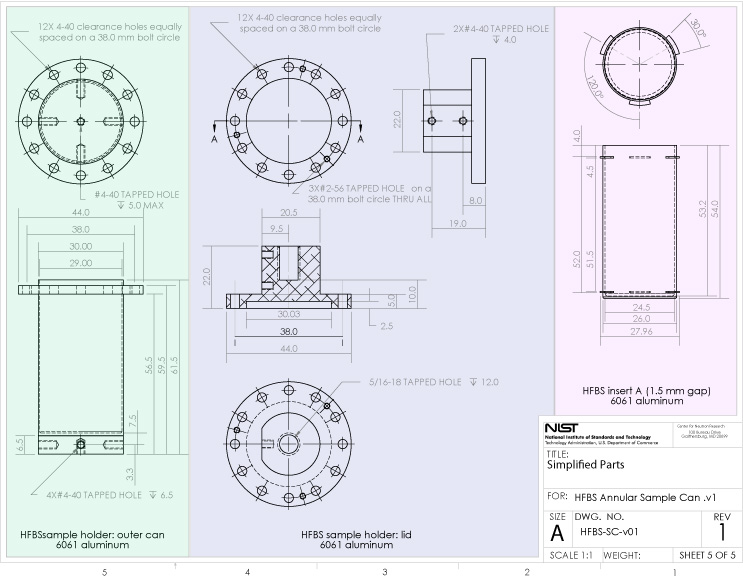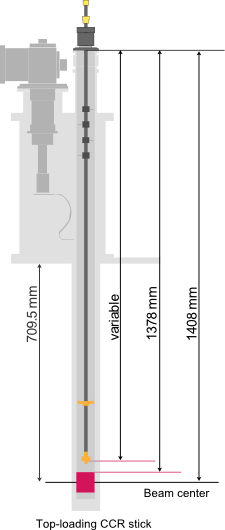Pages
- Publications
- Instrument Details
- Instrument Performance
- Sample Environment
- How to get beamtime
- How to get site access
- DAVE software
- Backscattering Links
- CHRNS
HFBS: Sample Environment
The geometry of the backscattering spectrometer is such that the equipment from the general sample environment pool are not necessarily compatible with the instrument. We have a dedicated set of equipment that covers most of the conditions required by those who perform experiments on the HFBS. If you are unsure whether your experimental requirements can be met, or if you have special requirements, please contact one of the instrument responsibles.
Additional information provided by the NCNR sample environment team can be found by visiting their webpage.
| Cryostat | Closed cycle refrigerator | Furnace | ||
| Temperature range (K) | 1.7 to 300 | 4 to 325 | 300 to 1700 | |
| 50 to 600 | ||||
| Maximum sample can diameter (mm) | 45 | 68 | 30 | |
| Maximum sample can length (mm) | 160 | 180 | 160 | |
| Mounting hardware (length = 7 mm) | M8 or 5-16/18 stud | M8 or 5-16/18 stud | M8 stud | |
| Mount-beam center distance (mm) | 0 - 80 | 15, 35, 48, 60 | 0 - 80 | |
| Gas handling (1/8'' stainless steel tube) | Yes | Yes | No | |
Sample cans
The sample cans that are generally used on the HFBS are made of aluminum and are sized to be commensurate with the neutron beam dimensions. These cans can be sealed with either indium or lead o-rings, depending on the temperature range desired. A drawing of the cans and one of the inserts is shown below. Plans for the HFBS annular sample cans can be downloaded (opens a new window) in pdf format.

|
Experiments that access temperatures in excess of 800 K cannot use aluminum cans. For these measurements, some appropriate can materials are niobium and platinum. We have a limited number of such cans available, but please be sure to coordinate with one of the instrument responsibles to plan your experiment, as there are some other special requirements involving the furnace.
Sample Mounting information
Below are the mounting heights for the different sample environments.
Top-Loading CCR

The Top-loading Closed Cycle refrigerator is the default sample environment on HFBS since it is the most commonly used. It is a top-loading version of the well known CCR (aka displex- see description below). The sample is placed at the bottom of the stick and then inserted into the sample well.
| Sample Diameter | 2.25 in |
| Sample Height to Beam | 1408 mm |
| Minimum Temperature | 3.4 K |
| Maximum Temperature | 700 K |
Link to the closed-cycle refrigerators website.
Link to the top-loading CCR manual.

The HFBS cryostat is a 50 mm ILL-style cryostat with a specially designed tail-set to fit into the sample space on the spectrometer. It is equipped with a gas fill line that can be attached to your sample holder.
| Sample Diameter | 1.77 in |
| Sample Height to Beam | 1304 mm |
| Minimum Temperature | 1.4 K |
| Maximum Temperature | 300 K |
Link to the cryostat website.
Link to the cryostat manual.

The CCR (aka displex) is mounted into an aluminum bucket we call the "top hat" and then lowered into the sample pit on the HFBS. Depending on the particular CCR that is used, it may be necessary to use spacers between the CCR flange and the top hat. A gas fill line can be installed on the CCR.
| Sample Height to Beam | 141.3 mm |
| Minimum Temperature | 10 K |
| Maximum Temperature | 325 K |
Link to the closed-cycle refrigerators website.
Link to the general use CCR manual.

The HFBS has a dedicated furnace with a 30 mm sample well. Please note that this is narrower than the standard 50 mm well. In addition, the geometry of the well, with a very long insert stick, imposes an additional constraint on the sample can. It is crucial that the sample be contained within a cylinder of diameter 30 mm concentric with the sample stick after it is mounted in the furnace. Please be sure to contact us if you intend to use the furnace on HFBS.
| Sample Height to Beam | 1304 mm |
| Minimum Temperature | 200 K |
| Maximum Temperature | 1400 K |
Link to the furnace website.
Link to the HFBS furnace manual.
Links to sample environment setups on the sample environment website:
Sample volumes based on annular inserts. Ideal volume is slightly higher than volume in the beam. These values should also be helpfull when choosing an insert to give 10% scatting sample.
| Annulus | Vol. in Beam | Max Vol. |
| 10. mm | 18.85 cm3 | 33.93 cm3 |
| 5.0 mm | 5.27 cm3 | 9.50 cm3 |
| 1.5 mm | 4.03 cm3 | 7.25 cm3 |
| 1.0 mm | 2.73 cm3 | 4.92 cm3 |
| 0.5 mm | 1.39 cm3 | 2.50 cm3 |
| 0.4 mm | 1.12 cm3 | 2.02 cm3 |
| 0.2 mm | 0.56 cm3 | 1.01 cm3 |
| 0.1 mm | 0.28 cm3 | 0.50 cm3 |

